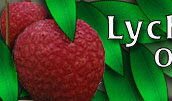I am often asked about whether grafted lychee trees are better than air-layered trees.
It depends on the following list of criteria:
-
The variety of lychee you wish to grow.
-
The location you wish to grow that particular variety.
-
The habit of growth you wish to achieve.
The standard commercial process for propagating lychee trees is via the method known as air-layering or marcotting.
This involves girdling a strip of bark and interrupting the cambium on a nicely shaped branch. High volume air-layer production is usually applied to branches ½ - 1 inch in diameter.
The cambium is the vascular plant tissue that supplies the roots of the tree with nutrition that has been photo-synthesied in the leaf canopy of the tree.
A bolus of moist rooting material contained in a sheet of foil or plastic is applied around the bare strip.
Over a period of 7 - 10 weeks roots form in this foil container.
When the foil ball is fully filled with roots the branch is cut off below the strip and planted either in a container or directly into the ground.
An air layered tree, unlike a grafted tree, does not possess a tap root.
Instead, an air-layer will form a relatively large spreading root system.
This larger root system will lead to accelerated growth.
In a grafted tree, a cutting of a particular variety (the scion) is attached to an already established root stock.
The graft union involves getting the cambium of the scion to align with the cambium of the rootstock and then sealing this union from exposure to bacteria and pests.
Different methods of grafting can be used, such as veneer grafting and chip budding, but the most common graft type is known as a cleft graft.
If all goes well the union of the scion and rootstock heals and you end up with one variety of tree growing on another variety.
The root stock may be an air layer of a common variety or it may be a seedling.
Generally speaking, plant varieties are grafted onto a seedling rootstock that is best suited for a specific soil growing condition. In the case of fruit trees such as apples, peaches or citrus the rootstock is selected to be resistant to soil pathogens specific to a geographical region.
Usually, rootstocks are selected for their resistance to soil nematodes and fungi.
Unfortunately, lychee trees are difficult to graft.
This means that unless great care and excellent grafting technique are applied the graft will not take.
So, for a lot of grafts you may end up with no results.
The end result of this is increased expense and from the large scale growers perspective this is not so desirable. On the other hand if you want a tree that is dwarfed (you have a very small yard or a container) grafting may be a desirable alternative.
There are certain varieties of lychees that do not tolerate soils with a high pH. This is typical of limestone soils such as those found in southern Dade County, Florida (the county where Miami is located). One variety that will not grow well in lime rock is the Emperor. The Emperor is a unique lychee that produces an enormous, juicy fruit with a tiny seed. To grow an Emperor in limestone soils you must graft the tree and the end result is a dwarfed slow growing specimen. If you grow an Emperor in Western Broward County where the soils are old Everglades muck then you can plant an air layered emperor directly into the ground and it will grow magnificently. This is because muck soils have a very high organic content and the levels of humic acids give the soil a lower and closer to neutral pH. Lychees thrive in more acidic soils with a high organic content. This is one of the reasons that mulching around lychees greatly improves their growth rate and overall health.
So in answering original questions if you had asked what is the best way to propagate Brewsters and Mauritiur trees for planting in Western Broward I would say air-layering. If you want to grow an Emperor tree in south Miami it needs to be grafted.

